#U.S. Army MAPS
Explore tagged Tumblr posts
Text
Army Bundling Professional Services Acquisition From Industry Into One Contract Marketplace
MAPS, will be a multiple-award, indefinite delivery/indefinite quantity acquisition vehicle for a variety of IT and engineering services ranging from cybersecurity, program management, and business process reengineering, to research, development, testing and more.

View On WordPress
#government contracting#Government Contractors#government innovation#Labels: Government Service Contractors#U.S. Army MAPS
0 notes
Text

I've seen sheriff's houses and old police stations with holding cells, but I've never seen a whole jailhouse converted to a home. This is so cool, but I have some concerns- it's a 1914 completely renovated jailhouse in Ozark, AR. 3bds, 2ba, 2,512 sq ft, $600k.


I love this old timeworn look. Here's the central hall entrance.


They did an open concept living area. Is this done correctly though? It looks like you wouldn't want to touch the walls.

The dining table between the living room and kitchen.

Here in the corner they've got a table for two so they can look out at the Arkansas River.


The description calls this a gourmet kitchen. The stove does look professional.
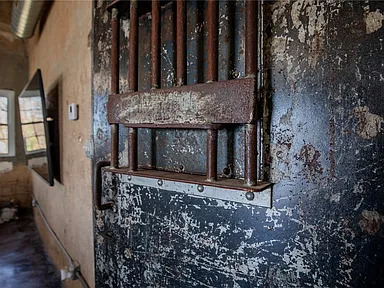
These doors.

Looks like some sort of work room.

In this shower room, is there some sort of sealant on the old floor? B/c I would have to wear flip flops in there- it looks kind of yucky and porous.

This is a small bedroom #1.

Down at the end of this hall of cells you can see bathroom #1 for the main floor. Are all the surfaces sealed? Shouldn't they be?

Here we have the stairs to the upper level. Looks like a medieval castle door, doesn't it?

The stairs have a small landing, then lead to a long stairway.

Bedroom #2 is also small.


The primary bedroom is the largest. Everything looks like it's going to continue to deteriorate.

Then, this is the 2nd bath, which is the largest. Geez, the floor looks so bad, and I see that they put in a square of cement. But, what about the wall and floor in the shower?

It also has the washer/dryer in here.


They made this room a family room with a kitchenette in the corner. (If the place is haunted, you wouldn't want to go downstairs at night to get a snack.)


The 1,537.67 sq ft lot is right next to the railroad tracks and on the banks of the river.

There's a great view of the bridge.

And, the river. I noticed, on the map, that the U.S. Army Corps of Engineers is nearby. I wonder if they would answer any questions the new buyer would have about structure, lead, the river overflowing, etc. (I mean, I live on the banks of a river and they came & installed this massive "thing" to finally stop it from overflowing.)
https://www.zillow.com/homedetails/209-W-River-St-Ozark-AR-72949/2068714482_zpid/?
#old jail conversion#historic jailhouse conversion#unique homes#houses#house tours#home tour#homes under $625k
127 notes
·
View notes
Text
(June 13, 2025)
(...)
The recurring massacres of Palestinians rushing to food distribution centers, with at least 245 Palestinians killed in the past two weeks, have shocked many. But these incidents should not distract us from the structural change: instead of hundreds of food distribution centers operating across the Gaza Strip by experienced international organizations, Israel set up only four centers for over two million people. That is not how to meet the needs of a population after many months of devastation and deprivation. It’s how you starve and strip survivors of their human dignity.
The location of the four centers is no less important. One is in the central part of the Strip along the Netzarim Corridor, and three in the south, west of Rafah. A quick look at the map is enough to understand: there is no connection between the locations of the “distribution centers” and the needs of the people.

An Israeli army map showing the location of aid distribution centers. (IDF Spokesperson)
Instead, the goal is to promote “moving the population” southward, ideally into the “concentration zones.” Since this constitutes a crime against humanity, Israel employed concealment tactics: first expelling established aid groups that could provide aid efficiently, then outsourcing distribution to opaque entities like the U.S.-backed Gaza Humanitarian Foundation (GHF).
As early as May 11, Benjamin Netanyahu reportedly stated in a secret session of the Foreign Affairs and Defense Committee that “receiving aid would be conditional on Gazans not returning to the places from which they came to the aid distribution sites.” This policy’s underlying logic was confirmed by Dr. Tammy Caner, a lawyer and director of the Law and National Security Program at the Institute for National Security Studies (INSS), a think tank with close ties with the Israeli military.
Indeed, the recent and sudden U-turn by Israel’s far-right Finance Minister Bezalel Smotrich — who went from vehemently opposing any aid to “Arabs” to endorsing it so “that the world does not stop us and accuse us of war crimes” — should also be understood as an endorsement of Netanyahu’s scheme to use food distribution to extort Gazans into “consenting” to their displacement.
Dr. Caner also confirmed that according to most experts, if Israel’s stated concern is Hamas seizing aid supplies, the logical solution would be flooding Gaza with abundant provisions in order to eliminate any single group’s ability to monopolize resources. But in fact, monopoly is precisely the point: Israel wants it for itself, to wield it as leverage against the civilian population. Starvation and distribution under the occupier’s conditions are two complementary methods of using food as a weapon.
A dangerous failure
Facilitating “population transfer” through the denial and conditional provision of basic necessities is not a new Israeli tactic. In a yet-unpublished study, I found that in the early 1950s, Israeli authorities systematically weaponized access to essential supplies, primarily against Palestinians and to a lesser but significant extent against Jews (mostly Mizrahim) whom the state sought to use to settle frontier regions.
Yet it remains unclear whether the starvation-transfer plan is achieving its intended goals. Reports from Gaza suggest that those reaching distribution centers are primarily the ones physically strong enough to walk several kilometers and carry back a week’s worth of food. Meanwhile, Israel has so far failed to compel the hundreds of thousands remaining in northern Gaza to make the long journey south — and at this stage, has also failed to stop many from returning. After all, who would embark on such a grueling trek if they can’t bring food back to their loved ones who stayed behind?
Does this mean the danger is diminishing — that starvation-transfer plan isn’t working? Not necessarily. The plan is still in its early stages and if allowed to continue, the suffering it produces could very well achieve its intended effect. More importantly, in the absence of public criticism, oversight, or meaningful international pressure, the likely response to the short-term failure of coercive measures is escalation: more destruction, more violence. There are already signs of this in northern Gaza, which comes after the army’s complete flattening of Rafah. The apparent goal of this systematic demolition of vital infrastructure and residential buildings is to force residents out in a way that makes return impossible.
There is even explicit confirmation of this intent in leaked remarks by Netanyahu during the same session of the Knesset’s Foreign Affairs and Defense Committee: “We’re destroying more and more homes — they have nowhere to return to. The only natural outcome will be that Gazans will want to emigrate out of the Strip. Our main problem is with receiving countries.”
This is what the ongoing bombings are designed to accomplish: to continue the waves of destruction from previous months and render northern Gaza, along with other areas, uninhabitable. The major transfer project remains very much on the table, with various factions of the Israeli right — both inside and outside the government — actively involved.
The outcome of ‘concentration zones’
Where are people supposed to go if they cannot withstand the unbearable pressure? For months, Israel has been in talks with potential “receiving countries” — a selection of authoritarian regimes that, one can assume, are weighing factors like regime stability, international legitimacy, and, undoubtedly, what they would receive in return for their cooperation. But as long as there’s a lack of willing “receiving” countries, the question remains: where, exactly, is Israel trying to transfer these people?
Israeli authorities openly speak of creating three so-called “concentration zones” within Gaza itself. These areas appeared on a leaked map published by The Times on May 17, based on diplomatic sources. But the map is misleading: it omits the fact that residents have already been expelled from the entire border area of the Gaza Strip, and that a systematic campaign of demolition has already taken place there. According to official statements, Gazans will not be allowed to return or live in those areas.
In a map published in Haaretz a week later, the designated “concentration areas” appear even smaller. According to rough estimates, the Gaza block covers around 50 square kilometers, the central camps block about 85, and the Al-Mawasi coastal strip just eight.
Data gathered by humanitarian organizations also confirms that Palestinians in Gaza continue to be expelled into ever-smaller territories. Before the war, impoverished Gaza already had a population density comparable to that of London. If Israel succeeds in forcing the civilian population into the zones marked on the Haaretz map, over 2 million Gazans would be crammed into just 40 percent of the Strip. The resulting density would reach approximately 15,000 people per square kilometer — living in a scorched landscape, stripped of infrastructure.
Official Israeli spokespeople refer to these as “concentration areas,” but their limited size, the prohibition on exiting them, and the near-total absence of infrastructure or means of survival, makes it possible to confidently refer to them as concentration camps.
Realistically, there are only so many ways to confine millions under military oversight on a narrow strip of land. For military and political leaders, the leaking of maps and plans serves another function: to test the waters — to see if anyone will resist, to find out just how far they can go before encountering consequences. Maybe they’ll manage to concentrate the survivors into three “concentration areas.” Maybe the end result will be something else. Do you really want to wait to find out?
No master plan required
My Palestinian friends will say: of course, as we’ve said all along, the Nakba is not a single event, but an ongoing process. That’s entirely true. But that shouldn’t mean we miss the significance of what is happening right now.
First, dispossession and expulsion unfold at a variable pace, with periods of acceleration and escalation, as well as stretches of stabilization. There have even been moments of modest, yet meaningful, Palestinian return. What we are witnessing now is an almost inconceivable acceleration of forced displacement.
Second, pace is not only a matter of time. When the pace of the process accelerates, so does its brutality. The line between ethnic cleansing and extermination can vanish quickly, almost automatically, when armed forces accelerate the process without restraint. In conditions of war, without international oversight and under the cover of chaos, a failed or stalled transfer can slide into mass killing.
That’s how transfer turns murderous, especially when it stalls. The repeated displacement of people within the confined territory of the Strip is not only designed to sever them from their homes, but also to rip apart the fabric of their lives. Some die “on their own.” Others become a “problem” that must be solved through yet more brutal means. Systematic destruction creates a new reality: entire areas rendered uninhabitable, which then seemingly justifies further expulsion on “humanitarian grounds.” The forced relocation to so-called “concentration areas” produces unbearable living conditions by design.
When people seek relief from the crushing pressure, the exit door may open, but only in one direction. The alternative? Life inside the “concentration areas” may at some point push the population to resist, in any way they can. Such resistance could then be used as a pretext for policing raids, for revenge operations, for massacres — all of which would accelerate the process. It’s entirely possible that faced with the failure to corral people into massive holding pens, to force them out of Gaza, or to “manage” the humanitarian catastrophe it has itself created, the army will push the murderous dynamic even further."
63 notes
·
View notes
Text
some interesting things about Frontier Crucible
Armie Hammer wears the same pair of boots while playing Edmund as he wore in THE LONE RANGER. He also carries the same gun, a Colt Single Action Army revolver, that he used in the 2013 Western.

Armie Hammer was cast in the movie by unconventional means, as he was unrepresented at the time. Producer Dallas Sonnier instructed casting director David Guglielmo to send a DM on Instagram to Tyler Ramsey, Armie's best friend. Ramsey and Hammer were both big fans of a Sonnier-produced western BONE TOMAHAWK, and took the incoming message seriously. 24 hours later, Sonnier and Guglielmo closed a deal with Hammer's attorney for him to star in the movie.

Scouting for "Patchee Wells", the water hole location in the script where most of the action takes place, began in 2021 and continued off and on for three years. Director Travis Mills researched options throughout the Southwestern U.S. and even considered locations in Italy and Romania. He accidentally stumbled on the water coves located at Watson Lake in Prescott, Arizona when scanning Google Maps for a nearby national forest. The city owned park of Watson Lake and the nearby Granite Dells became the primary location of the film.
58 notes
·
View notes
Text
Israel bombed a cancer hospital today. one of many other hospitals and places of shelter they have bombed not only since the 7th of October but over the years. and yet some of you still dare to take a neutral stance or even still support Israel. Israeli news call over 8000 civilians killed as 'terrorists we eliminated' and you still dare to ask people to condemn Hamas and "look at both sides" there is only one thing any kind of resistance is called and its terrorists. the oppressor is the oppressed and the resistance (the only militia that Palestine has btw, while Israel posseses nuclear weapons and army funded by the U.S) are terrorists. those who fight for freedom and human rights of their people after being colonised 75 years ago (yes; Israel is a colonial state that has been there for only 75 years and it's existence is anti-therical to the Judaist belief itself)
but look at the Israeli hostages that Hamas took, i am looking at them and i see people forgotten by their government and used as an excuse to annihilate Palestinians. When revealed by a released hostage that hamas keeps them in tunnels Israel announces they will flood the tunnels with nerve gas. if you lack reading comprehension let me repeat. when Israel learns where their hostages are kept they decide to just kill everyone inside, alongside their citizens they care so much about and genocide Palestinian population over. When Hamas offers to release the hostages under the condition of ceasefire, Israel denies. Three times. Israel has killed around 50 of their own people since the 7th of October because you guessed it ! the only thing they care about is wiping the Palestinians out. The families of the hostages are calling for an immediate ceasefire.
The blindness of you people is incomprehensible. your ignorance blows my mind. one look at the map, one quick read about the history of Palestine and Israel, one look at the military forces, the number of martyrs, tells you all you need to know about this "war" that isn't a war but an ethnic cleansing that Israel has been doing since 1948.
Pray for the peaceful rest of those martyred and never forget. But most importantly pray for the living Palestinians and a free Palestine.
#free palestine#from the river to the sea palestine will be free#palestine#stop genocide#gaza strip#free gaza
872 notes
·
View notes
Text
"The globe" and the Empire.
---
By the dawn of a century christened as both the American and the geographic century, [...] European explorers and cartographers actively filled the last [apparently] remaining terrae incognitae [on their maps and globes] [...] and excited economic [...] interest [...] in near and far parts of the world and their markets. As imagined [...] in ambitious [...] projects such as the "Millionth Map" [...] in 1891, this world was deemed a sufficiently homogeneous entity […]. [A]t least among the white, free populations of various metropoles[,] […] Europeans [...] established one single imaginary of the world, [...] a meticulously surveyed global environment. [...] On the Western side of the Atlantic, on the other hand, maps and globes heralded, braced, and promoted the expansionist projects of [...] a century of national coming of age for the United States [...] [and its] spatially unsettled, globalizing empire. [...] Americans viewed maps and globes [...] as "arbiters of power" [...]. Drawing a direct line between geography and wars of empire, President McKinley, for instance, told an audience of missionaries […] that, once his prayers to God about the “Filipino question” had been answered, his first presidential order was for “the chief engineer of the War Department (our map-maker) to put the Philippines on the map of the United States” [...]. [H]oping to materialize the "global Monroe Doctrine," [...] Americans [...] needed to pay special attention [...] to those recently-made-cognita regions (such as the Philippines, Hawaii, Guam, and Puerto Rico [occupied by the US]) [...]. Americans' lives were mapped onto a cartographically known, commercially accessible, cognitively smaller world [...]. As [proclaimed in an address from 1898] [...], On our breakfast table lies each morning the toil of Europe, Asia, and Africa, [...] unseen millions, and countless myriads weave and plant for us; we have made [...] life broader by annihilating distance [...].
Text by: Mashid Mayar. "What on Earth! Slated Globes, School Geography and Imperial Pedagogy". European Journal of American Studies 15-2. Summer 2020.
---
Simply put, World War II made the United States a planetary presence. State Department officials furiously churned out wartime memos establishing U.S. policy - often for the first time - regarding every nation, colony, region, and sub-duchy on the map. [...] In 1898 imperial expansion had inspired new maps. The 1940s wartime expansion yielded a similar burst of cartographic innovation. [...] Life devoted a fifteen-page spread to the “Dymaxion map” [...]. More popular was the “polar azimuthal projection” perfected by the dean of wartime cartography, [R.E.H.]. [...] The map was an enormous hit, reprinted and copied frequently. [...] The U.S. Army ordered eighteen thousand copies, and the map became the basis for the United Nations logo, designed in 1945. “Never before have persons been so interested in the entire world,” gushed Popular Mechanics. [...] The world must be seen anew, the poet Archibald MacLeish wrote, as a “round earth in which all the directions eventually meet.” “If we win the war,” he continued, “the image of the age which now is opening will be the image of a global earth, a completed sphere.” That word MacLeish chose, global, was new. [...] If the last war was a world war, this one was, as Franklin Delano Roosevelt put it in September 1942, “a global war.” That was the first time a sitting president had publicly uttered the word global, though every president since has used it incessantly. For Christmas that year, George Marshall presented FDR with a five-hundred-pound globe for the Oval Office. Placed next to Roosevelt’s desk, it was comically large. It resembled the globe with which Charlie Chaplin had performed an amorous dance two years earlier in The Great Dictator, only bigger. [...] “Just as truly as Europe once invaded us, with wave after wave of immigrants, now we are invading Europe, with wave after wave […],” wrote the journalist John Hersey in 1944. Except it wasn’t only Europe. The “invasion” landed in force on every continent [...].
Text by: Daniel Immerwahr. How to Hide an Empire: A History of the Greater United States. 2019.
---
The US space shuttle Endeavour maintains a British spelling because it was named after Captain James Cook’s famous ship [...]. [V]essels symbolize an empire’s use of narratives of technological progress to expand toward the “ends of the earth” in ways that naturalize dominance over the global commons [...]. Cook claimed Indigenous Pacific lands for Britain while under orders to discover and claim the famed southern continent, Terra Australis Incognita - what eighteenth-century Europeans imagined to be the ends of the earth. [...] As the Pentagon declared in 1961, the “environment in which the Army, Navy, Air Force, and Marine Corps will operate covers the entire globe and extends from the depths of the ocean to the far reaches of interplanetary space” […]. Extraterritorial spaces, such as the high seas, Antarctica, and outer space, are imaginatively, historically, and juridically interconnected. Their international legal regimes […] [were] developed in the midst of the Cold War […]. Denis Cosgrove [...] points to the [...] [late eighteenth-century British Empire's] encirclement of the globe through Cook's navigation of the seas, which allowed for colonial claims to expand to a planetary scale. [...] This circumnavigation in turn led to [...] establishment of Greenwich mean time as a world standard [...]. [T]his encirclement is both a spatial claim to the planet and a temporal one, in that it plots time from a British center. [...] In the memorable words of [...] McLuhan [from 1974, relating to US surveying] [...]: "For the first time the natural world was completely enclosed in a man-made container [...]." The first photograph of the earth from outer space was taken by a V-2 rocket shot from the White Sands Missile Range in New Mexico in 1946 […]. [A]n Apollonian eye, [...] the [...] photographs [...] were part of a context in which […] popular US magazines used wartime cartography in ways that naturalized militarism and empire under the guise of a unifying view of the globe.
Text by: Elizabeth DeLoughrey. "Satellite Planetarity and the Ends of the Earth". Public Culture, Volume 26, Issue 2, pages 257-280. Spring 2014.
90 notes
·
View notes
Text
Matt Shuham at HuffPost:
EL PASO, Texas — The armored military vehicles President Donald Trump has sent to the U.S.-Mexico border weigh 50,000 pounds apiece and have thermal and infrared cameras said to be able to spot “a little mouse up to a mile out.” That feature might appeal to Trump, who has referred to people who cross the border without authorization as “rats” who “infest” the nation.
Last week, when a soldier emerged from one of the hulking eight-wheelers, armed with a pair of binoculars and a grimace, he briefly turned his attention away from the U.S.-Mexico border. He turned over his left shoulder, looking inward at the United States — and at me. He was one of the approximately 10,000 members of the U.S. military who are now stationed at the border, many of whom now patrol areas where, according to the president, they have the authority to detain civilians. Over the last few weeks, Trump has directed the military to take control of thousands of acres of land along the border in Texas and New Mexico, treating nearly 250 miles of the U.S.-Mexico border as de facto military installations known as “National Defense Areas.” As a result, people who cross the border in these areas are now not only susceptible to charges of illegal entry but also of trespassing on a military installation. This escalation also purportedly gives soldiers the legal authority to detain civilians for trespassing. In short: Trump has issued a hugely significant order for troops to detain people for civilian criminal violations on American soil. At the U.S.-Mexico border last week, I saw what a national military police force might look like.
Arriving At The Border
On top of increased air surveillance and logistical support, there are now at least three massive, armored Stryker vehicles each in Texas and southeastern New Mexico. The Strykers themselves aren’t armed, but the soldiers within them carry rifles, as do others along the border. (About 50 such vehicles arrived at the border in April; it’s unclear how many are in use.)
Four other journalists and I participated in a U.S. Army tour last week, being shepherded around the borderlands in a sprinter van. Beginning at Fort Bliss, we first drove through downtown El Paso, Texas, to the bollard fence that marks many urban borders with Mexico. We passed through the gate, going south, and our van lurched between sandy potholes until we stopped underneath the Bridge of the Americas. For the first time in American history, soldiers have purportedly been given the authority to detain people in the New Mexico and west Texas borderlands on the grounds that they are trespassing on a military base. Though the 1878 Posse Comitatus Act restricts the use of the military for domestic law enforcement, a loophole known as the military purpose doctrine allows exceptions where soldiers are working to further a primarily military function, like guarding a military base. Trump’s recent orders take advantage of this loophole. You might be able to spot the circular logic. The hundreds of miles of new “military installations” along the border have provided the grounds for hundreds of trespassing charges, and potentially thousands more in the future. The purpose of those charges is to protect the military bases. Those bases, according to the military, are part of an overall effort to “seal the southern border and repel illegal activity,” as well as “denying illegal activity along the southern border.” But the trespassing charges now central to that effort would not be legal if the bases didn’t exist. According to the military, these new National Defense Areas range from 60 feet to over 3 miles deep, though the Army has not released maps to make their exact dimensions clear. Analyzing land transfer data earlier this month, a spokesperson for Sen. Martin Heinrich (D-N.M.) told SourceNM the border militarization scheme has serious implications for anyone driving along New Mexico State Road 9 “who might pull over to stretch their legs and unwittingly trespass on a military base.” [...]
At least so far, the arrests have been carried out by Border Patrol agents, not soldiers. But that could change, especially if the number of unauthorized border crossings ticks up as temperatures cool in the fall. Also, so far, it appears no U.S. citizens have been charged with trespassing on the border installations — but there’s nothing in the legal authorities cited by the Trump administration that would preclude that. These developments are just the latest in decades of border militarization. The United States, under presidents of both parties, has built hundreds of miles of fencing along the U.S.-Mexico border in recent decades. The Border Patrol recently celebrated its 100th birthday, and especially since Sept. 11, 2001, border enforcement has grown more and more aggressive, featuring high-tech surveillance equipment and thousands of armed agents, the presence of whom — especially as recent presidents have attacked asylum rights along the border — tends to push people into isolated, barren parts of the desert. In recent years, members of the military have served in a support capacity along the border, helping with logistical tasks and surveillance. Still, Trump has accelerated this trend in his second term. Now, there are 10,000 soldiers along the border as part of the federal mission, up from 2,500 in January. And the threat of trespassing charges is palpable. Veteran border journalist Todd Miller wrote this month that on a recent trip to attempt to take photos of the new Defense Department signage, he noticed a camera system on an unmarked truck that appeared to be tracking his movements. [...] Similar boasts about the military’s ability to one-up Border Patrol officers are common in Operation Lone Star, the governor of Texas’ parallel (but unrelated) mission to militarize that state’s border using Texas National Guard soldiers, state troopers and state trespassing charges. That mission has also been marred by alleged human rights abuses and gratuitous political theater. Still, even before the declaration of National Defense Areas, crossings were already at historic lows, as they began dropping during the Biden administration due to much larger forces. Mexico, under pressure from the U.S., has for years moved aggressively to use its military and law enforcement to keep migrants away from the U.S. border. And both Trump and former President Joe Biden dramatically cracked down on asylum rights on the border, in Biden’s case with a numerical cap, and in Trump’s by simply declaring border crossings to be an emergency, and eliminating asylum rights almost altogether. As of last Thursday, the Army claimed it had made 190 “detections” since the New Mexico National Defense Area was first established in April — a minuscule number compared with Border Patrol’s day-to-day work.
HuffPost’s Matt Shuham went on tour to the US/Mexico Border to preview what a potential national military police force would look like under the Trump Regime.
Read the full story at HuffPost.
#Immigration#Border Security#US/Mexico Border#Trump Administration II#Posse Comitatus Act#National Defense Areas#Operation Lone Star#Border Patrol#ICE
46 notes
·
View notes
Text
What to Know About June 14 “No Kings Day” Protests
By Jacob Knutson
June 13, 2025
Share on Facebook Share on Twitter
Share on Bluesky

Millions of people are set to rally across the nation in opposition to President Donald Trump’s extreme agenda and to counterprogram the military parade in Washington, D.C.
Dubbed “No Kings Day,” the over 2,000 planned demonstrations are set to kick off Saturday morning, June 14. The protests have been organized by hundreds of organizations and grass-roots groups, including the ACLU, Public Citizen, Indivisible and 50501.
A full map and list of events can be found here. For those who can’t attend in person, some media outlets are set to stream protests from multiple cities around the U.S.
“No Kings Day is about standing up for our democracy. Standing up for our rights, our liberties and making sure that we are sending a strong message that we are going to have a free and fair democracy,” Deirdre Schifeling, the ACLU’s chief political and advocacy officer, told Democracy Docket Friday.
“We’ve had this democracy for 250 years,” Schifeling said. “As imperfect as it has been, we are going to keep that democracy.”
No organized demonstrations are planned in D.C over safety concerns, Schifeling said.
youtube
Earlier this week, Trump from the Oval Office threatened to meet those who protest the multimillion dollar military parade with “very big force.” The parade marks the Army’s 250th anniversary, but it also falls on the president’s 79th birthday.
“We didn’t want there to be a conflict or any excuse to have a conflict with peaceful protesters and this military parade,” Schifeling said, adding that those in the district can attend close-by events in Maryland and Virginia. She also noted a flagship protest in Philadelphia.
Following Trump’s lead, some Republican governors and law enforcement officials have issued their own threats against protesters.
Texas Gov. Greg Abbott (R), mobilized 5,000 Texas National Guard troops in anticipation of demonstrations and dared protesters to “FAFO,” an acronym for “F— around and find out.”
“We will kill you graveyard dead,” Florida Sheriff Wayne Ivey said in a warning to demonstrators Friday.
“I think those statements are outrageous,” Schifeling said. “I view this kind of speech and rhetoric as absolutely inflammatory and condoning of violence against peaceful protesters, people who are exercising their First Amendment right.”
Schifeling said those attending events should be aware of what rights they have to demonstrate and highlighted the ACLU’s “Know Your Rights” page.
While the demonstrations are in part response to the military parade, they also come amid Trump’s ongoing use of military personnel in Los Angeles. Trump’s use of the military in California will largely be decided by the courts, but Schifeling said people organizing is also key in affecting what happens.
“Courage begets courage,” she said. “The best thing that we can do to save our democracy is stand up together peacefully and say no.”
26 notes
·
View notes
Text


In 1975, the United States Army Corps of Engineers (Seattle District, Environmental Resources Section) released The Washington Environmental Atlas (aka: Provisional U.S. Army Corps of Engineers Environmental Reconnaissance Inventory of the State of Washington 1975), a 114 page book that cost over $200,000 to make and over 3yrs to research and compile. The atlas contains official maps, graphs, status levels, and reports regarding phytogeography, zoogeography, physical geography, and land use borders for the state of Washington. Also included are archeological sites, rivers and lakes of environmental interest, notable geological features and historical and contemporary points of interest. The book went into great detail describing the native plants of the state (Sitka Spruce, Pacific Dogwood, Wood Rose, Yellow-Eyed Grass, etc.) as well as the native animals (Bald Eagle, Coastal Cutthroat Trout, Roosevelt Elk, American Pika, etc.). Some species were even given their own individual pages which provided even more detail than other species. One of these native creatures that were given their own page is the legendary Cryptid known as Bigfoot.
91 notes
·
View notes
Text
Fast & Furious: The Mother
Luke Hobbs x OC



Summary: An assassin comes out of hiding to rescue her daughter, whom she left earlier in life.
Fast & Furious presents The Mother: Family runs deep. Vengeance runs deeper.
Part One
The Call
The shrill ring of the phone sliced through the quiet of the night, its sound jarring and insistent. Veda Burgos, former U.S. Army operative turned private contractor, sat upright in her bed, the sheets tangled around her legs. The room was dimly lit by the soft glow of a bedside lamp, casting long shadows on the walls. She reached for the phone with a practiced calm, her fingers brushing against the cool metal before lifting it to her ear.
"Veda," the voice on the other end was low, gravelly, and unmistakable.
"Luke," she replied, her voice steady despite the rush of emotions the mere sound of his name stirred within her. "It's been a while."
"Too long," he agreed. There was a pause, a hesitation that spoke volumes. "I need your help."
Her heart skipped a beat. "What happened?"
"Samantha's been taken," he said, the words heavy with urgency. "By Dante Reyes."
The name hit her like a physical blow. Dante Reyes, the son of Hernan Reyes, the criminal mastermind whose empire had once threatened to engulf them all. She had crossed paths with Dante before, during a mission that had nearly cost her everything. She had thought him dead, a casualty of their last encounter. But now, he was back, and he had their daughter.
"Where is she?" Veda's voice was sharp, her mind already shifting into mission mode.
"Cap-Haitien, Haiti," Luke replied. "I have a team ready, but I need you to lead it. You're the only one who knows how he thinks."
Veda closed her eyes, taking a deep breath. The weight of the situation settled over her like a cloak. She had left that life behind, the life of danger and constant peril. But family, her daughter was a line she would never cross. She had trained for this, lived for this. And now, she would return to it.
"I'm in," she said, her voice unwavering.
Veda clenched her jaw, her voice calm but steel-laced. “Send me the coordinates. I’m coming.”
The next few hours were a blur of activity. Veda moved through her home with precision, gathering gear, reviewing intel, and contacting old allies. She hadn't anticipated returning to the field, but the urgency of the situation left no room for hesitation.
Her home, once a sanctuary, now felt like a staging ground. Maps of Haiti were spread out on the dining table, red pins marking known locations of Dante's operations. Satellite images flickered across her laptop screen, each one scrutinized for any clue that might lead her to Samantha.
She donned her tactical gear which was black combat boots, cargo pants, a fitted shirt, and a vest equipped with various tools and weapons. Her hair was pulled back into a tight ponytail, and her face was set in a mask of determination. She was ready.
As she prepared to leave, her phone buzzed with a message from Luke: Meet me at the airstrip in one hour.
She nodded to herself, grabbed her bag, and headed out the door.
Her flight was silent. Charter jet. Off-grid.
She read the intel Hobbs sent which was brief, encrypted, clinical. Samantha had been targeted because of her bloodline. Dante Reyes was continuing the legacy of his father Hernan, using violence and vendettas to break those who destroyed his empire. Hobbs had crossed him.
Now Dante wanted blood.
But he made one mistake.
He took a mother’s daughter.
The Airstrip
The sun hung low over the Haitian horizon, casting long gold streaks across the tarmac. A private airstrip carved out of jungle and salt-worn stone buzzed with quiet urgency. Two Falcon aircraft idled nearby, their engines humming like thunder on standby.
The crew which consisted of Dominic Toretto, Letty Ortiz, Tej Parker, Roman Pearce, Han, Gisele, Tess, and Ramsey stood in a loose semi-circle near the cargo hold, double-checking their gear and loading crates of weapons and tech.
The stillness broke as the black SUV tore across the dusty runway. It skidded to a stop near the group, and Hobbs stepped out of the driver’s side, towering as ever in tactical gear, his jaw clenched tight.
He rounded the vehicle and opened the passenger door. And she stepped out. Fierce. Dressed in matte-black fatigues. Her brown eyes were sharp, scanning the team in an instant. She moved like a soldier, quiet and precise. The air shifted with her presence.
Everyone straightened.
“Damn,” Roman muttered, under his breath. “Who’s the queen of shadow ops?”
Hobbs raised a hand. “Listen up.” The murmurs died. All eyes turned to him.
“This is Veda Burgos. She’s ex-Army Spec Ops, classified black-tier contractor, and she’s saved my ass more times than I can count.” He turned toward her, his voice softer, but still heavy with weight. “She’s also my wife. Or... was.”
Veda gave a slight nod. “Let’s not get distracted by titles.”
Letty arched a brow, folding her arms. “So you’re the one we’ve heard absolutely nothing about.”
Dom, calm but observant, extended a hand. “Welcome.”
She took it. Firm grip. No hesitation.
“We’re going after my daughter,” Veda said, looking from face to face. “Samantha. You all know what we’re up against. But I need you to understand something, this isn’t just another mission. If we don’t get to her in time, Dante Reyes won’t just use her to get to Hobbs. He’ll break her to get to me.”
The team nodded, silently absorbing her words. Hobbs stepped beside her. “She’s the best there is. And I trust her with my life.”
Roman cleared his throat. “Okay, but real quick—how come we’ve never heard of her before? Like, never? Not even in a 'back-in-the-day' story?”
Tej elbowed him. “Because that’s what real ghosts do, man. They don’t leave stories.”
Veda gave Roman a small, deadly smile. “Let’s just say I wasn’t on the party circuit.”
Ramsey clicked her tablet, bringing up a holographic 3D map of the compound.
“Glad you’re here. We need every hand we can get,” she said. “Dante’s fortified the site with military-grade tech, infrared sensors, heavy weapons, and a kill-switch on the prison floor.”
“Then we go in silent,” Veda said. “We ghost the perimeter, neutralize the guards, and extract the asset, my daughter. No noise, no mistakes.”
Letty smirked. “I like her.”
Han stepped forward, nodding. “So do I.”
Hobbs looked at them all, then down the runway toward the rising heat waves.
“Gear up,” he growled. “We leave in fifteen.”
Veda turned back to the Falcon jet, walking shoulder to shoulder with Hobbs. For the first time in years, they moved like they used to do. One rhythm, one mission.
Hobbs slightly turned his head to her, his eyes scanning her form before settling on her face.
"You look the same," he said, his voice tinged with something she couldn't quite place.
"Time hasn't been kind to you," she replied, her tone teasing but with an edge of sincerity.
He offered a small smile, but it didn't reach his eyes. "Let's get to work."
As she climbed the ramp, Veda paused and looked over at him. “Of course,” she said. “This is about bringing my daughter home. And I’ll burn the world down to do it.”
He didn’t doubt her.
And as the Falcon lifted off the runway, slicing through the Haitian dusk, they followed her lead into the storm.
Cap-Haitien
The jet touched down in Cap-Haitien under the cover of darkness. The humid air hit Veda as she stepped onto the tarmac, the scent of saltwater and earth mixing in the night air. She adjusted her gear, her senses sharpening as she surveyed the surroundings.
Luke joined her, his presence a steadying force. "Intel suggests Dante's compound is about five clicks from here," he said, consulting a handheld device. "We move out in ten."
Veda nodded, her mind already calculating the best route. She trusted Luke's information, but she would verify it herself. She always did.
The team assembled, a mix of seasoned operatives and local contacts. They moved out swiftly, navigating through the dense jungle underbrush, their movements coordinated and silent. Veda led the way, her instincts guiding her through the terrain.
As they neared the compound, the sounds of the jungle faded, replaced by the eerie quiet of the enemy's stronghold. Veda signaled for the team to halt, her eyes scanning the perimeter.
"Two guards at the entrance," she whispered. "We take them out silently, then breach."
Luke gestured for the team to spread out, each member taking their assigned position. Veda and Luke moved in tandem, their actions fluid and precise. Within moments, the guards were neutralized, their bodies hidden from view.
They approached the compound's main building, a fortified structure that loomed ominously in the moonlight. Veda crouched beside the door, assessing the best way to gain entry.
"Explosives?" Luke suggested.
Veda shook her head. "Too risky. We go in quiet."
She produced a small device from her belt and attached it to the door's lock mechanism. Within seconds, it clicked open. She pushed the door slightly ajar, peering inside.
The interior was dimly lit, the air thick with the scent of mildew and decay. They moved in, their footsteps muffled by the worn floorboards.
They navigated the labyrinthine hallways of the compound, each turn bringing them closer to their goal. The tension was real, every shadow a potential threat. Veda's hand hovered near her weapon, ready for anything.
They reached a reinforced door at the end of a narrow corridor. Veda signaled for the team to halt. She approached the door, listening for any sounds from within. Hearing nothing, she placed her ear against the cold metal, her senses straining.
A faint sound like a muffled sob reached her ears. Her heart clenched. It was Samantha.
She turned to Luke, her expression hardening. "She's in there."
Luke nodded grimly. "Let's move."
They breached the door, weapons raised. Inside, the room was empty but there was a monitor playing a video of a crying Samantha.
“You really think I would make this easy for you, Hobbs,” Dante’s voice crackled over comms. “And hello, Veda, nice of you to come out of hiding. I look forward to meeting you again,” He chuckled.
Veda's fists clenched at her sides, her knuckles whitening. Anger surged within her, hot and fierce. But beneath that anger was a cold, calculating resolve. Dante had made a grave mistake. He had underestimated them.
They boarded the jet once more, the engines roaring to life as it taxied down the runway. Veda settled into her seat, the familiar hum of the aircraft grounding her. She pulled up the mission parameters on her tablet, reviewing them once again. Dante Reyes was a dangerous adversary, a man who had orchestrated chaos and destruction with a twisted sense of justice. He had taken their daughter, and for that, he would pay.
Luke sat across from her, his gaze fixed on the horizon. The silence between them was thick, laden with unspoken thoughts and shared history. It was a silence that spoke of battles fought and lost, of promises made and broken. But it was also a silence that spoke of unity, of a bond forged in the crucible of adversity.
"How has she been?" Veda asked, her voice breaking the stillness.
Luke's eyes softened, a flicker of warmth amidst the storm. "She's been strong," he replied. "Just like her mother."
Veda smiled faintly, her heart swelling with pride. Samantha had always been resilient, a trait she had inherited from both of them. She was their daughter, their flesh and blood, and she had the strength to endure whatever Dante threw her way.
But Veda knew that strength alone wouldn't be enough. They needed more. They needed the full force of the Hobbs family.
"We need your brothers," Veda said, her tone brokering no argument.
Luke's expression hardened, a flicker of defiance in his eyes. "Absolutely not," he said, his voice low and firm.
There was no way Luke was involving his eight younger brothers: Jonah, Mateo, Kal, Timo, Enele, Enoka, Laki, and Fetu in this. They had their own lives, their own battles. This was his fight, his responsibility.
But Veda was unyielding. "This is about Samantha," she said. "We need more people to rescue her."
Luke met her gaze, the weight of her words sinking in. She was right. They couldn't do this alone.
With a heavy sigh, Luke relented. "Take the jet to Samoa," he told the pilot.
As the jet soared into the sky, heading toward the distant islands of Samoa, Veda allowed herself a moment of reflection. The path ahead was fraught with danger, the stakes higher than ever. But she was ready. They all were. Dante had made a grave mistake. And they were coming for him.
Part Two
#luke hobbs#fanfic#fanfiction#fast and furious#fast and furious fanfiction#dwayne johnson#the rock#fic#fanfic writing#writing fanfic#fast & furious#dominic toretto#mia toretto#letty ortiz#han lue#roman pearce#mr nobody#the agency#jey uso#jimmy uso#solo sikoa#roman reigns#naomi#jacob fatu#slight au#the mother#cipher#cars#Fast & Furious universe#family
23 notes
·
View notes
Text






National Poetry Month: Craig Santos Perez
Craig Santos Perez (b. 1980) is a Chamorro writer; born in Guam, his family moved to California when he was fifteen. The poems highlighted here are from his 2017 collection from Unincorporated Territory [lukao] published in Oakland by Omnidawn. This is the fourth title in his continuing unincorporated territory series and continues Santos Perez's exploration of Chamorro language, culture, diaspora, as well as the legacy of the U.S. Military bases on Guam. In 2023, the fifth book in the series, [åmot], won the National Book Award for Poetry.
[lukao] – procession – weaves poems centering his wife and the birth of their daughter with, “other processions, including extinction, military buildups, environmental degradation, climate change, violence, and death.” Santos Perez revisits motifs from the first three volumes of the series – including the legends of juan malo, and an endless, ecstatic consideration of SPAM:
My food philosophy / is simple: I eat therefore I SPAM. The name itself stands for: / Specially Processed Army Meal, Sacred Pork And Medicine, / Super Pink Artificial Meat, Snake Pigeon And Mongoose, or / Some Pigs Are Missing.
Santos Perez layers humor, lyricism, personal narrative, social-media-speak, history, myth, Chomorro language, maps, and rhythm to illuminate a complex and rich heritage of Guam, while providing a frank assessment of colonization and militarization.


Watch Santos Perez perform SPAM's Carbon Footprint at a festival in 2016.
See other National Poetry Month posts!
--Amanda, Special Collections Graduate Intern


#national poetry month#craig santos perez#chamorro#guam#guahan#lukao#from unincorporated territory#omnidawn#SPAM#micronesia#poetry
31 notes
·
View notes
Text
Excerpt from this story from Rolling Stone:
As Elon Musk‘s Department of Government Efficiency (DOGE) continues to wreak havoc with the internal mechanics of the federal government in its efforts to gut and dissolve vital agencies, the White House is signaling that it has no problem with the richest man on the planet serving as his own ethics watchdog.
Speaking to reporters on Wednesday, White House Press Secretary Karoline Leavitt fielded a question about Musk being a special government employee while his various companies have billions in government contracts, and whether the Trump administration was taking steps to curtail the many conflicts of interest that has created. Leavitt replied that the president had already addressed this concern, saying that “if Elon Musk comes across a conflict of interest with the contracts and the funding that DOGE is overseeing, Elon will excuse himself from those contracts.”
Of course, it’s nearly impossible for Musk to direct any action by DOGE in Washington without potentially affecting one of his businesses. X, formerly Twitter, currently faces a lawsuit from the Securities and Exchange Commission that alleges he withheld information about the stake he was acquiring in the company ahead of his bid to purchase it. The Department of Labor, which could be next on the chopping block for DOGE, has probed and fined Tesla and SpaceX for unsafe working conditions through the Occupational Safety and Health Administration. Tesla is also under investigation by the Justice Department for possible securities and wire fraud related to its unsupported claims about fully autonomous vehicles.
SpaceX has additionally been fined by the Environmental Protection Agency and the Federal Aviation Administration — and Musk personally pressured the last FAA administrator to resign, leaving the agency leaderless when a commercial passenger jet and U.S. Army helicopter collided in mid-air over the Potomac River in D.C. last week, killing 67 people. (Transportation Secretary Sean Duffy said on Wednesday that DOGE staff were going to “plug in to help upgrade our aviation system.” Duffy’s department includes the National Highway Traffic Safety Administration, which has its own ongoing investigation into Tesla’s self-driving features.) The Equal Employment Opportunity Commission is suing Tesla over alleged racial harassment at a manufacturing plant, and the National Labor Relations Board has tangled with both Tesla and SpaceX, with the result that Musk’s companies and other corporate behemoths are waging a legal battle to see the agency declared unconstitutional and wiped off the map for good.
20 notes
·
View notes
Text
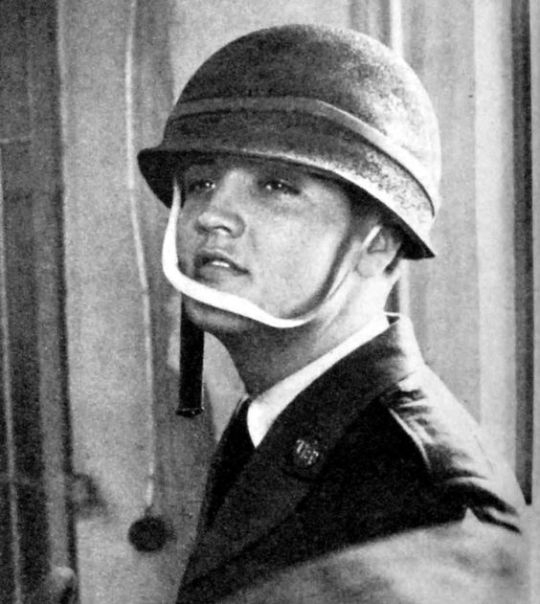
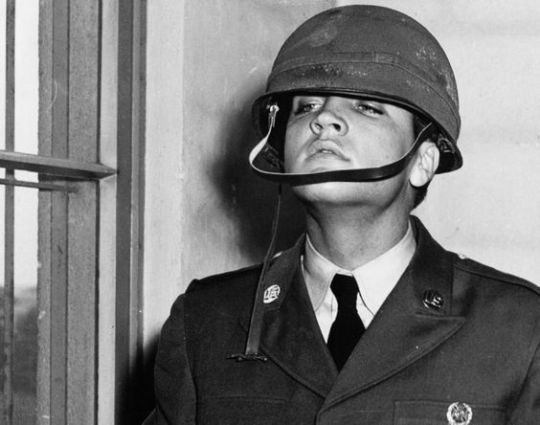
Official publicity photos during the army. Friday, October 3, 1958, Elvis at Ray Barracks in Friedberg, Germany. Elvis had arrived in Germany on the morning of October 1st.
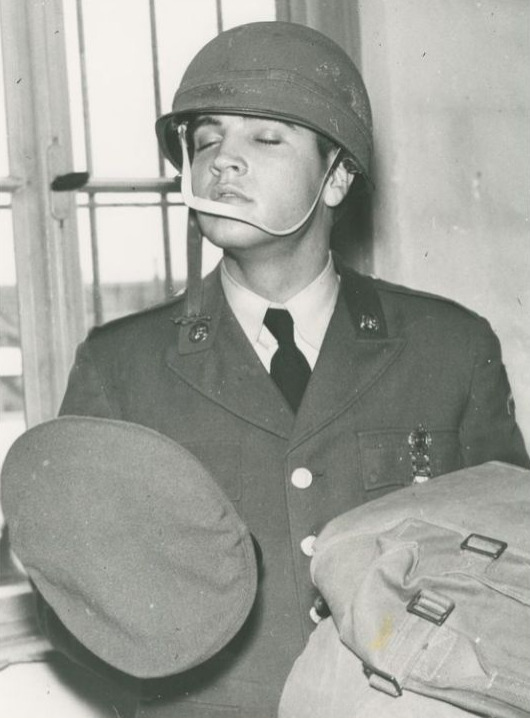
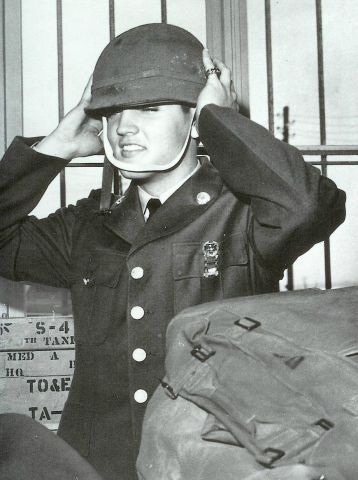




The newspapers had been reporting that Presley was initially assigned to join the crew of a medium Patton tank. However, before Elvis arrived in Germany, he said his last assignment had been driving a truck for four weeks in Fort Hood. The army announced the new assignment was made after reviewing Presley’s military tests and records, and an interview with his company commander. This is the reason why on October 3 Elvis first posed with the Company D sign for publicity photos, but just a few days later was photographed with the Headquarters sign.

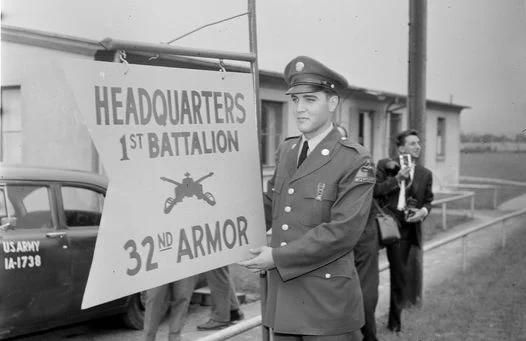
“The assignment of scout jeep driver is given to soldiers of above normal capability,” an army official explained. “The soldier must be able to work on his own, map-read and draw sketches, know tactics and recognize the enemy and enemy weapons.” A rumor started circulating that Elvis was transferred due to a perforated eardrum which meant he had to avoid loud noises of artillery fire. “That rumor didn’t make much sense to me,” Lt. Taylor commented. “It’s implausible that the army medical exam system had failed to detect such an ear problem long before Elvis was assigned to a tank company.” During the day, Elvis was driving jeep “HQ31” for the Master Sergeant of a scout platoon, Ira Jones from Arkansas, who had served in World War II and the Korean War and was a Purple Heart recipient. However, Presley was not just a jeep driver. According to Jones, each scout “was trained to operate in enemy territory with or without vehicles.” The scout platoons were the first ones who would see the enemy in combat. As a result, Jones was quite impressed that Elvis did not try to get out of his assigned position to serve in the field with his Reconnaissance Platoon. “As time passed, Elvis became our friend and we hoped that he would stay with us,” recalled Sgt. Jones. “We could count on him to be a member of the team… By the time Elvis had been with us six or seven weeks, we were confident that he was going to succeed in the U.S. Army.”
Excerpt from "Elvis: The Army Years Uncovered · Behind The Scenes Of The Two Years That Changed The King Of Rock 'n' Roll's Life" by Trina Young (2021)
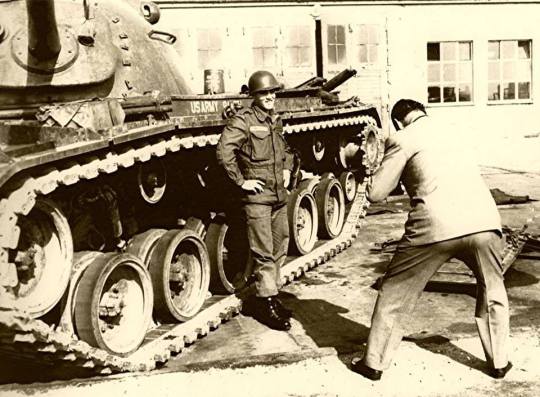

Official publicity photos during the army. Friday, October 3, 1958, Elvis at Ray Barracks in Friedberg, Germany.
#elvis presley#germany#1958#elvis#50s elvis#elvis history#army history#elvis the king#army elvis#elvis fans#elvis fandom
61 notes
·
View notes
Text
As Yale University historian Timothy Snyder recently posted on X, “The only war that [Russian President Vladimir] Putin is winning is inside [U.S. President Donald] Trump’s head. Putin only wins the war on the ground by setting American policy, through Trump.”
And, boy, is Putin succeeding. What transpired between Trump, U.S. Vice President J.D. Vance, and Ukrainian President Volodymyr Zelensky in the Oval Office on Feb. 28 was remarkable—not only for the undiplomatic blow-up, but for the clarity it provided on how Trump and his surrogates view the war. The most persistent among their views is the idea that Ukraine is rapidly losing the war to an unstoppable Russian army and that the only way out of this is to give in to Putin’s demands.
Time and time again during the exchange at the White House, both Trump and Vance attempted to hammer this idea into Zelensky, telling him that “you don’t have the cards right now,” “you’re not winning this,” and “your country is in big trouble.” Since then, Trump has doubled down on social media, posting that “Russia is absolutely pounding Ukraine on the battlefield right now.”
These claims do not correspond to the reality on the ground, but they are exactly what Putin needs Trump to think. For Putin, the narrative of an inevitable Russian victory makes it appear invincible in Western eyes and, more importantly, spreads the idea that any assistance to Ukraine is futile and merely prolongs the war. As Trump gifts Putin with unrequited concessions, including the suspension of military aid and intelligence sharing with Ukraine, it’s becoming clearer that Washington has joined Moscow’s side.
Trump is making his claims at a time when Russia’s actual advance—rather than the imaginary one in his head—has stalled in key contested areas. According to DeepState, a Ukrainian project mapping the course of the invasion, the Ukrainian military has taken back several occupied areas in local counteroffensives in recent days. One of these areas is Pokrovsk, a city that Russian forces have been unsuccessfully attempting to capture since last August. Mikhail Zvinchuk, a former Russian Defense Ministry spokesperson who now runs Rybar, a popular pro-war Telegram channel with more than 1.3 million subscribers, reported in his latest front-line dispatch that Russian forces have suffered a number of painful setbacks in Toretsk, a mining town in Donetsk Oblast that Moscow declared as “liberated” in early February. There are similar reports about Chasiv Yar, another front-line city where the Russians have been bogged down.
The stalled Russian army is a shadow of its former self. Its most capable and elite units are long gone, ground down by fierce Ukrainian resistance in the first few weeks of the war. Stocks of tanks, armored vehicles, and even trucks are perilously low; Russian soldiers at the front have increasingly resorted to donkeys and horses to move supplies.
Worse, the small gains Russia has made over the past year and a half have come at a terrible loss of life. At the time of writing, open-source data confirms close to 96,000 regular Russian troops have been killed in action, with the likely real number to be at least 160,000. Adding the seriously wounded brings Russia’s irrecoverable combat losses to an estimated 550,000, according to recent report by the International Institute for Strategic Studies. There are drone videos of Russian soldiers limping on crutches or crawling on stumps of their legs toward the Ukrainian positions. Their final mission: to act as bullet sponges that reveal Ukrainian fire nests.
The reality on the front has nothing to do with the Kremlin narrative of an infinitely resourced Russia on a relentless, unstoppable march—a narrative that has been swallowed hook, line, and sinker by Trump and the MAGA movement.
Official Russian media is still full of bombastic triumphalism, but Russians who are closer to the war do not see their country as winning—or capable of winning by military means alone. Ilya Mersh, a pro-war blogger with deep ties to Russia’s top military command and about 600,000 subscribers on Telegram, directly contradicted Vance on Ukraine. On Feb. 20, Mersh wrote, “Vance claims that Russia has an overwhelming advantage in manpower and equipment, and that Ukraine doesn’t stand a chance. Let’s take a closer look at that. Throughout this entire war, we’ve never actually had a numerical advantage in troops—at some points, we were even outnumbered.”
Yuri Kotenok, one of the most prominent front-line war bloggers, wrote on Telegram that “the Ukrainians are becoming bolder by the day, counterattacking and even pushing us out of several defended positions.” He complains about “a severe shortage of troops for assault operations” in southern Donetsk.
To find fresh recruits, the Russian army has long been scraping the bottom of the barrel. Anastasia Kashevarova, another passionately pro-war blogger, explained that people with severe physical handicaps, mental health issues, and drug addictions are being tricked into signing up.
Igor Girkin, one of Russia’s most prominent and vocal pro-war nationalists, now serves a prison sentence for his criticism of Putin for not pursing the war relentlessly enough. In a note from prison, he recently wrote that the war is lost. Russia has not reached any of its strategic goals, he said, and Ukrainian forces have stood as equals to the Russian army. According to him, the country’s failure in the war means its entire future is now bleak. “The systemic crisis in which our country finds itself still has no prospect of resolving and will deepen,” Girkin concluded.
Some of the most passionate pro-war Russians are grappling with the grim realization that the war is not the grand historical struggle they envisioned, but a slow, grinding catastrophe. Modest Kolerov, an ultranationalist blogger and former Kremlin spin doctor, lamented in a widely shared post that the war “has proven beyond doubt that ‘New Russia’ is nothing more than … a pale shadow of historical Russia—whether the Russian Empire or the Soviet Union.” This sentiment, once confined to the opposition, is now creeping into the rhetoric of the pro-war camp itself.
These are all telling signs of just how far the Kremlin’s narrative has unraveled. But perhaps the best indication of the shifting mood over the war inside Russia is a video that has gone viral on Telegram. Originally appearing on a Russian account with more than 1 million subscribers, it shows Russian soldiers freezing in a trench, desperately awaiting news of a cease-fire. Unlike earlier propaganda pieces that framed the war as a patriotic duty or a lucrative adventure, this video invited sympathy for the exhausted, war-weary troops.
If Russia has a chance of winning this war, it will not be because of its military achievements on the battlefield. It will be because Putin has convinced Trump, Vance, and their MAGA acolytes that Russia holds all the imaginary cards.
15 notes
·
View notes
Text
THIS DAY IN GAY HISTORY
based on: The White Crane Institute's 'Gay Wisdom', Gay Birthdays, Gay For Today, Famous GLBT, glbt-Gay Encylopedia, Today in Gay History, Wikipedia, and more … December 20



1785 – The last known execution for sodomy in the United States occurs in Pennsylvania. Joseph Ross is the victim.


1904 – The American actor and director Albert Dekker, who died in unusual circumstance in 1968, was born in Brooklyn, New York, as Albert Ecke. His films include the classics The Man in the Iron Mask (1939), Beau Geste (1939), The Killers (1946), The Sound and the Fury (1959), Suddenly, Last Summer (1959), and The Wild Bunch(1969). He replaced Lee J. Cobb as Willy Loman in the original production of Arthur Miller's Death of a Salesman, and during a five-year stint back on Broadway in the early 1960s, he played the Duke of Norfolk in Robert Bolt's A Man for All Seasons.
Dekker appeared in some seventy films from the 1930s to 1960s, but his four most famous screen roles were as a mad scientist in the 1940 horror film Dr. Cyclops; as a vicious hitman in the The Killers; as a dangerous dealer in atomic fuel in the 1955 film noir Kiss Me Deadly; and as an unscrupulous railroad detective in Sam Peckinpah's western The Wild Bunch, which would be his last screen appearance.
Dekker's off-screen preoccupation with politics led to his winning a seat in the California State Assembly in 1944. Dekker served as a Democratic member for the Assembly until 1946. During the McCarthy era he was an outspoken critic of U.S. Senator Joseph McCarthy's tactics; to avoid being blacklisted he spent most of the period working on Broadway rather than Hollywood.
For his contribution to the motion picture industry, Dekker has a star on the Hollywood Walk of Fame at 6620 Hollywood Boulevard.
On May 5, 1968, Dekker was found dead in his Hollywood home after failing to answer numerous phone calls for two days. Although money and camera equipment were missing, there were no signs of forced entry. He was found naked, kneeling in his bathtub with a noose wrapped around his neck that was looped around the shower's curtain rod. He was also handcuffed, blindfolded, gagged and had "make me suck" and "slave" and "cocksucker" scrawled on his body in red lipstick.
The police toyed with a theory that Dekker was a closet homosexual who practiced his eccentricities very discreetly with anonymous male prostitutes, and that this time, something had gone wrong and the frightened partner had quietly let himself out. The coroner's ruling was accidental death by autoerotic asphyxiation.


1955 – Frank Kameny is fired from his job as an astronomer in the United States Army’s Map Service in Washington, D.C. because of his homosexuality. A few days later he is blacklisted from seeking federal employment. These events spur Kameny into being a gay rights activist.


1962 – Doug Wright is an American playwright, librettist, and screenwriter. He received the Pulitzer Prize for Drama in 2004 for his play, I Am My Own Wife.
A Texas native, Wright was born in Dallas. He was the target of schoolyard teasing and playground attacks throughout elementary school. Overweight and awkward as a child, and not athletically inclined, he was routinely taunted by classmates as a "sissy," a "queer," and worse.
Despite the torments he was forced to endure in elementary and middle schools, once he entered Highland Park High School, outside of Dallas, Wright found acceptance in the theater department.
He entered Yale University in the fall of 1981. He achieved early success while still an undergraduate, when one of his first works, The Stonewater Rapture (1983), a two-character play about teenage sexuality and religious repression in a rural Texas town, was performed to acclaim at Scotland's Edinburgh Festival Fringe in August 1984.
The works of Doug Wright often focus on the unconventional lives of society's outsiders. Among these are the iconoclastic artist Marcel Duchamp in Interrogating the Nude; the Marquis de Sade in Quills; Charlotte von Mahlsdorf, an East Berlin transvestite who survived persecution by both the Nazi and Communist regimes, in the Tony Award and Pulitzer Prize-winning I Am My Own Wife; and "Big Edie" and "Little Edie" Bouvier Beale, two eccentric American aristocrats who ended up living in squalor, sharing a once-elegant mansion, in the musical Grey Gardens, based on the cult classic documentary film of the same name.
Wright also helped adapt the animated Disney film The Little Mermaid into a Broadway musical.
He currently lives in New York City with his husband/partner, the singer-songwriter David Clement.


1980 – According to recently released stats, at least one person is physically assaulted in New York City each day because they are gay or lesbian.


11 notes
·
View notes
Text
The FBI is guarding the terrorist training camps!
Ask yourself who is allowing these Islamic training camps and why? This map is from 2017 and are the known Islamic training camps in the US at the time. This map doesn’t include CCP PLA fighters, Hezbollah Unit 910 and all of the Chinese Communist Party People’s Liberation Army saboteur training camps. Now there are at least 2,000 camps that we are aware of. Our tracking technology likely misses at least 15% due to the enemies use of faraday bags, gps blocking and spoofing technology, etc., etc.
Kamal Saleem is a former jihadist. Sent here by the Muslim Brotherhood (the very same Islamic organization that put Huma next to Hillary and Barack Obama protected, Hamas IS the Muslim Brotherhood but not all Muslim Brotherhood are Hamas) to attack America from within. He knows the Muslim Brotherhood’s inner workings, their strategies, their tactics, and their goals. Any interviews with him would be worth a listen.
After carefully and methodically invading the U.S. and spreading across the U.S., awaiting their marching orders from Iran, rumors are Hezbollah Unit 910 was just activated. A wave of attacks are coming to a U.S. city near you!
Research and you’ll begin to understand this is an inside job.

18 notes
·
View notes